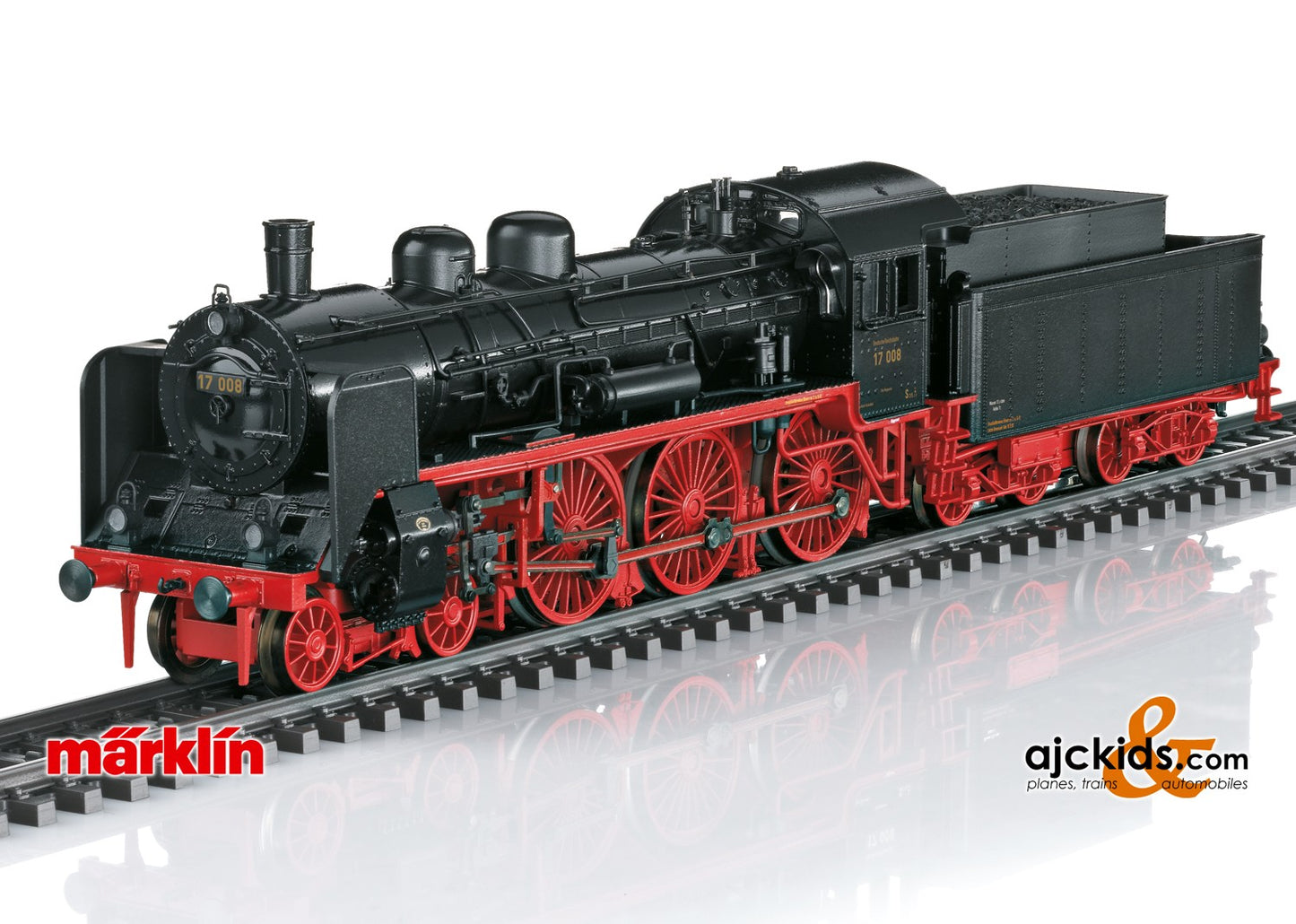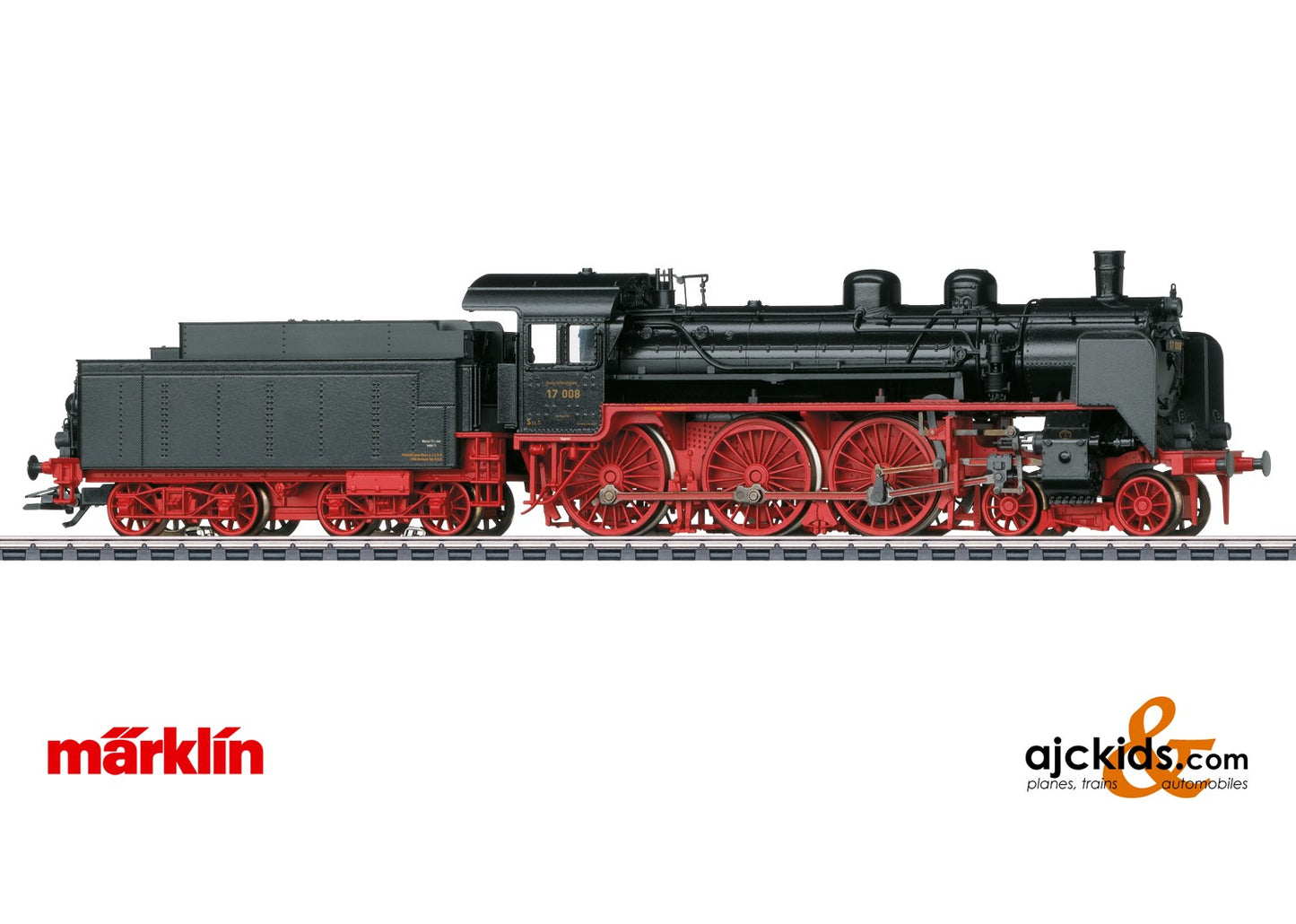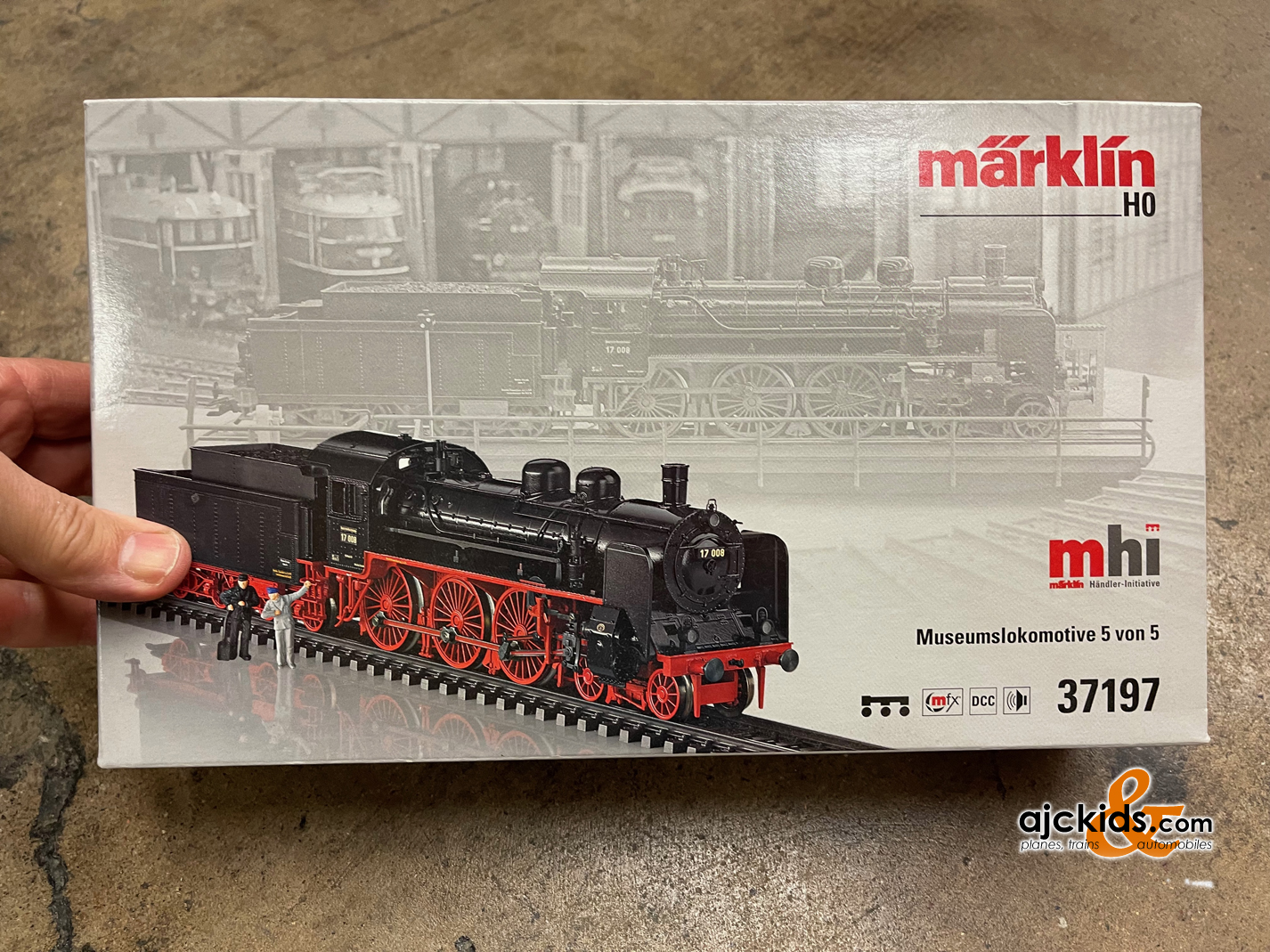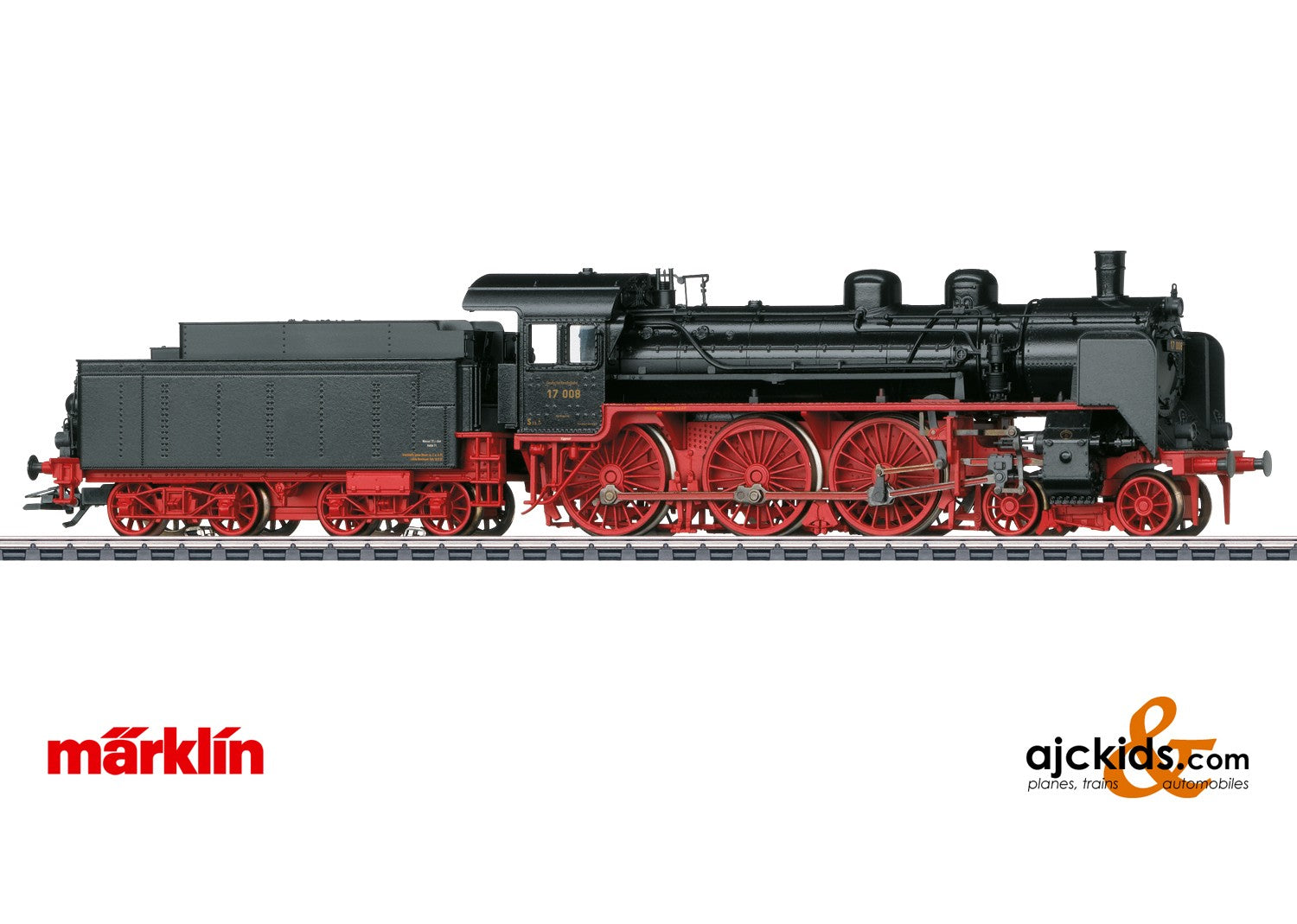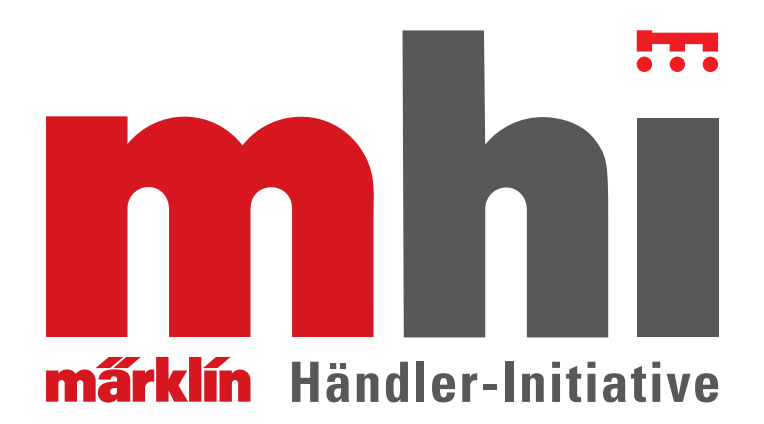Marklin 37197 - Class 17 Steam Locomotive (Museum)
Highlights
- Reworked tooling.
- New propulsion concept.
- Reworked locomotive and tender connection.
- Open cab with an open view through it.
- Cab lighting can be controlled digitally.
- Oncoming train light can be controlled digitally.
- Firebox flickering can be controlled digitally.
- Built-in smoke unit.
- Figures of an engineer and a fireman included.
- Booklet about the history of the locomotive included.
Product description
Model: The locomotive has an mfx+ digital decoder and extensive sound functions. It also has high-efficiency propulsion with a flywheel, in the boiler. 3 axles powered. Traction tires. The locomotive and coal tender are constructed mostly of metal. A smoke unit is built into the locomotive. The dual headlights change over with the direction of travel. They and the smoke unit will work in conventional operation and can be controlled digitally. The cab lighting, firebox flickering, and oncoming train light are each digitally controlled separately. Maintenance-free, warm white and red LEDs are used for the lighting. There is a close coupling with a guide mechanism between the locomotive and tender. There is a close coupler with a guide mechanism and an NEM pocket on the rear of the tender.
The minimum radius for operation is 360 mm / 14-3/16".
Protective piston rod sleeves are included. Figures of an engineer and a fireman are included for installation in the cab. A booklet gives information about the history of the locomotive.
Length over the buffers approximately 24.0 cm / 9-7/16".
One-time series.
Charlie's Tip
Fifth and last locomotive in the 5-part series of museum locomotives.
This model can be found in a DC version in the Trix H0 assortment under item number 25170.
Publications
- Summer New Items 2021Prototype information
Historical Background The purchasing policy for steam locomotives formed a large gap on the Prussian State Railways at the end of the 19th / beginning of the 20th century. This policy actually lagged constantly behind the real requirements. The reason for this was the generally "frugal" Prussian department head for locomotive purchasing, Confidential Design Engineer Robert Garbe, who still considered express locomotives with four driving wheels as the measure of all things among other things long after other German state-owned railroads had changed to locomotives with six driving wheels. The Prussian S 6 (later the DRG class 13.10) conceived by him and placed into service starting in 1906 was well suited for lightweight express train service on the flat terrain of the Prussian State Railways certainly thanks to its large driving wheels of 2,100 mm / 82-5/8" diameter. Yet, that was all that could really be said positive about it. Initially, the low adhesion weight of the S 6 frequently caused startup problems pulling heavy express trains, which according to contemporary observers "gradually led to operating problems".
This class was also no longer operationally feasible in hilly and mountainous terrain. The railroad management in particular at Kassel, Elberfeld, Frankfurt, and Erfurt therefore demanded with increasing urgency a new express locomotive with six driving wheels for their many main lines with longer grades. In contrast, Garbe initially favored his class P 8 (4-6-0, later DRG class 38.10) built starting in 1906 as an express locomotive, although it was generally not actually suited for express trains due to its driving wheel diameter of only 1,750 mm / 68-7/8" with rough running in the upper speed area at 80 km/h / 50 mph and higher. In addition, the first design of the P 8 exhibited a whole series of persistent teething problems before it underwent a thorough revision in 1913. In the end, Garbe had to accommodate himself to the instructions of the ministry and tackle the design of an express locomotive with six driving wheels. Initially, Garbe planned a simple enlargement of his P 8 with the driving wheels (to 1,980 mm / 77-15/16" diameter) as well as with the boiler and heating surface to solve the problem along the lines of his desires. Contrary to Garbe's ideas, the ministry was generally not thrilled with the notion of a two-cylinder locomotive.
On the other hand, for Garbe a superheated steam compound locomotive was beyond reproach, probably knowing, that other railroads had just obtained outstanding results with it. A compromise was finally agreed on a 4-6-0 superheated steam locomotive with four cylinders without compound effect, which viewed technically was not the last word on the subject. In the end, Berlin Mechanical Engineering, Inc. (BMAG, formerly Louis Schwartzkopff) was then given a contract in 1909 for two test locomotives of the new, initially class S 8 4-6-0 express locomotive.
The Prototype Locomotives
In the spring of 1910, BMAG delivered the first two units (builder numbers 4455 and 4456), which were then initially assigned as road numbers S 8 801 and 802 to the Erfurt District. The similarities to the P 8 were unmistakable. For ostensibly better access to the running gear components, the frame remained faithful to partially riveted and partially bolted prefabricated construction. The boiler of the P 8 was used with a larger firebox and a larger outer firebox as well as a longer boiler. This allowed the evaporative heating surface to be increased from 143 to 154.3 square meters / 1,430 to 1,543 square feet. The P 8 also contributed the large cab and you could almost be of the opinion that the running boards also had their origin here too. Its "low" construction required wheel wells over the first driving wheels.
Soon after being delivered, road number S 8 Erfurt 802 was presented at the Brussels World Exhibition on April 23, 1910 to amazed experts. Yet presumably, this Prussian "Frugal Variation" ultimately led a rather shadowy existence among the locomotives exhibited because Pacific express locomotives with compound drive (4-6-2) had already been running in Europe for three years. The stars of the exhibition were if anything the Bavarian S 3/6 and three Pacific locomotives from the French railroads. Even before the end of the exhibition on December 7, road number 802 returned to its base in Gefilde and underwent extensive test runs.
In the meantime, road number 801 had also been tested under normal operating conditions. In this period, two new designations must be mentioned: For a short time, both units ran as road numbers S 10 Erfurt 951 and 952, then as road numbers S 10 Erfurt 1001 and 1002. Overall, these two prototypes did not meet expectations whereby the insufficient boiler performance as well as the extremely difficult access to the internal running gear contributed negatively to the results.
The Standard Designs of the S 10 Including slight improvements, BMAG delivered a first regular production run of ten units in 1911 (road numbers S 10 Erfurt 1003, Breslau 1001-1004, and Mainz 1001-1005). Here the worst complaints due to poor access to the internal running gear were remedied, because the front of the frame was already being designed as a 100 mm / 3-15/16" thick bar frame and the running boards were mounted higher above the driving wheels.
The view in front had also changed with a lower buffer beam and slanting skirting across the entire width. In contrast to the prototypes, the cylinder block consisting of four equally large cylinders at the same level and including their valve gear housings were now two cast pieces bolted together in the middle. On the two prototype locomotives, three pieces had still been required. All four cylinders were linked to the first driving wheelset, which was designed as an offset axle, which now had a diagonal crank instead of vertical internal crank disks. Yet now the shortcomings of the boiler determined in operation led to an overhaul of the boiler design including controls by the firm Vulcan Stettin Mechanical Engineering, Inc., which had already made its name with other locomotive types by using basic development or improvement work.
The permissible boiler pressure was increased from 12 to 14 kilograms per square centimeter / 170.68 to 199.13 pounds per square inch, the grate area from 2.60 to 2.72 square meters / 26 to 27.2 square feet, and the firebox heating surface from 13.6 to 14.17 square meters / 136 to 141.7 square feet.
The evaporative heating surface was reduced only slightly (153.09 compared to 154.25 square meters / 1,530.9 to 1,542.5 square feet), yet the superheater heating surface increased due to a larger number of boiler tubes from 53.00 to 61.50 square meters / 530 to 615 square feet.
A slightly tapering smoke stack of 420 to 480 mm / 16-1/2" to 18-7/8" diameter was now used instead of the usual cylindrical unit previously used in Prussia.
Between 1912 and 1914, BMAG, Hanomag, and Vulcan delivered 190 units in the version described above. On the first units, the steam dome was initially located on the front boiler seam, the round sand dome behind it. They quickly changed places. While the first S 10 locomotives were initially coupled to the P 8 tender, the type 2‘2‘T21,5 (5 metric tons of coal), this was replaced as early as 1911 by the type 2‘2‘T31,5, which carried 7 metric tons of coal and 31.5 cubic meters / 8,321.42 gallons of water. This allowed the S 10 to have a range of about 300 kilometers / 188 miles without having to replenish water and coal.
Service
With just half of the total roster assigned to base stations, the railroad districts of Erfurt (47 units) and Münster (49 units) developed into strongholds for the S 10 locomotives. The second half were spread upon delivery to the districts of Breslau (10 units), Kassel (10 units), Cologne (4 units), Elberfeld (13 units), Essen (17 units), Halle (11 units), Kattowitz (10 units), Magdeburg (4 units), Mainz (13 units), and Saarbrücken (14 units).
The end of World War I signified a large bloodletting of these units, because in addition to the loss of territory mainly in the East a large number of the S 10 locomotives had to be surrendered to the victors because of the armistice treaty of November 11, 1918. Thirty-one locomotives remained in Poland (there then as road numbers Pk1-1 to 31) and in Lithuania six units (sold by France at the end of 1919, there then as road numbers Gr10-1 to 6). Italy received one unit (also sold by France, there road number FS 676.001), which however went to France in 1925 to Alsace-Lorraine (then road number AL 1162). Belgium snapped up 16 locomotives (as road numbers 6002-6013, 6033, 6040, 6041, and 6043), and France ended up with 12 S 10 units. The latter ran starting in 1920/21 in the region of Alsace-Lorraine on the newly established "Administration des Chemins de Fer d´Alsace et de Lorraine" as road numbers AL 1150-1161. In the meantime, the German State Railways was founded in Germany (starting June of 1921: German State Railroad, starting August of 1924: German State Railroad Company – DRG).
One of the large tasks then was to standardize the variety of different designation systems inherited from the provincial railroads. Starting September of 1925, the remaining 134 units of the S 10 were finally assigned new road numbers and from then on ran as road numbers 17 001-041 and 043-135. Strongholds of the class 17.0 were, starting in the mid-Twenties, the German State Railroad districts (RBD) of Cologne with about 30 units, Mainz with a fluctuating roster of 15 to 30 locomotives, Münster with around 30 to 50 units. Naturally, the two Rhine routes were predestined areas of use for several years for the Cologne and Mainz S 10 units, yet the respective surrounding areas were also not left out.
There were spectacular uses of these units in the Münster District on the "Rollbahn" / "Raceway Line" of Hamburg-Altona – Bremen – Osnabrück – Cologne as well as between Hannover – Osnabrück – Rheine – the Dutch border. Yet the deferred maintenance during the war as well as years of overwork with corresponding results for the running gear and cylinders did not let the actually still "young" S 10 locomotives grow old. In particular, the generally weak offset axle consisting of several assembled parts was a significant weak point. Whereas the idea that the locomotives were out of service due to too high fuel consumption can be relegated to the area of fairy tales. As early as 1926, the first five locomotives were retired and in 1927 another twelve units followed. Two more S 10 units were not caught up in this wave until 1930, and then it really began: 1931: 28 units, 1932: 25 units, 1933: 22 units, and 1934: 10 locomotives. The ranks of the remaining S 10 locomotives slowly continued to decrease in the next few years. In the process, several units occasionally found a livelihood as braking locomotives with Riggenbach resistance brakes at the Locomotive Test Facility (LVA) in Grunewald.
On December 31, 1940, the roster still hosted road numbers 17 039, 097, 102, 107, and 120. After the end of World War II, there were probably no more S 10 locomotives running in Germany. In the West Zones, road numbers 17 039 and 102 were retired on September 20, 1948. In the area of the DR in the GDR (East Germany) road number 17 107 remained stored in the Berlin District and was disposed of on February 15, 1951. Road number 17 120 found itself on the Polish State Railroad after the end of the war, was given a new road number there of Pk1-24 and was finally retired on February 28, 1952. Road number 17 097 went to Soviet Russia as war reparations, probably remained stored on the Lithuanian standard gauge network, and was retired in February of 1951. Road Number 17 008 Road number 17 008 can be viewed in the German Technology Museum in Berlin as the sole preserved unit of the class 17.0. Road number 17 008 was delivered on February 3, 1912 by BMAG (Berlin Mechanical Engineering, Inc., formerly Schwartzkopff) with builder number 4760 to the Breslau District as road number S 10 1008 Bsl. There this locomotive with nine other units hauled mostly express trains in the direction of Upper Silesia. Around 1924/25, this unit, now designated as road number 17 008 went to the Mainz District, where it was based at Mainz and was used chiefly on the Rhine routes. Yet there it was gradually replaced by the Bavarian class S 3/6 (class 18.4-5) and road number 17 008 thus went in the early summer of 1933 to the Düsseldorf storage yard in the Wuppertal District. Respectable performance however could no longer be expected there. Its daily work offered only local runs. Like many of its siblings, it quickly became superfluous and it was thus retired in October of 1934. Yet it was saved from being scrapped because the Brandenburg West maintenance facility restored it as a showpiece. In the process, its left side was cut away to demonstrate better the working of a steam locomotive. Eventually, it was given a place of honor on March 11 of the anniversary year of 1935 (100 Years of German Railroading) in the Berlin Transportation and Engineering Museum in the former Berlin-Hamburg Line Station, even on electrically driven rollers.
After World War II, the museum was not open to the public for a long time due to the special status of railroading in West Berlin. This was because the German State Railroad (DR) of the GDR (East Germany) also ran railroad operations in the West Sectors of Berlin and refused any access to all trackage by outsiders, except of course the stations and their platforms. It was not until 1984 with the takeover of the S-Bahn by the West Berlin Senate that ownership of the shutdown museum was acquired by the West. Sometime later, road number 17 008 was woken from its "Sleeping Beauty sleep" and transported on a depressed floor semi rig to the Neukölln Station and then moved on its own wheels across the Ringbahn or Ring Line to the Anhalt Freight Station.
Since October of 1987, it has enriched the German Technology Museum (until 1996 the Museum for Transportation and Technology) on the grounds of the former maintenance facility for the Berlin Anhalt Station, also here ready for demonstration on rollers.
Thomas Estler
Features
Warning
| Control Unit | Mobile Station | Mobile Station 2 | Central Station 1/2 | Central Station 3/2 | |
|---|---|---|---|---|---|
| Headlight(s) | X | X | X | X | X |
| Smoke generator contact | X | X | X | X | X |
| Steam locomotive op. sounds | X | X | X | X | X |
| Locomotive whistle | X | X | X | X | X |
| Light(s) for Oncoming Train | X | X | X | X | X |
| Engineer’s cab lighting | X | X | X | X | |
| Flickering Light in Fire Box | X | X | X | X | |
| Whistle for switching maneuver | X | X | X | X | |
| Direct control | X | X | X | X | |
| Sound of squealing brakes off | X | X | X | ||
| Air Pump | X | X | X | ||
| Letting off Steam | X | X | X | ||
| Sound of coal being shoveled | X | X | X | ||
| Tipping grate | X | X | X | ||
| Water Pump | X | X | X | ||
| Injectors | X | X | X | ||
| Sanding | X | ||||
| Replenishing fuel | X | ||||
| Replenishing fuel | X | ||||
| Replenishing fuel | X | ||||
| Switcher Double "A" Light | X | ||||
| Switching maneuver | X | ||||
| Flickering Light in Fire Box | X | ||||
| Rail Joints | X | ||||
| Safety Valve | X |
EAN/UPC: 4001883371979
